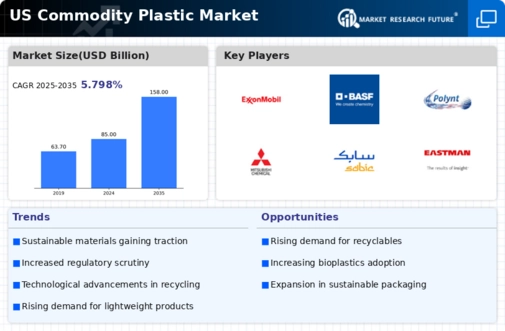The commodity plastic market in the US is characterized by a competitive landscape that is both dynamic and multifaceted. Key growth drivers include increasing demand for sustainable materials, advancements in recycling technologies, and the ongoing push for digital transformation across the supply chain. Major players such as Dow Inc. (US), ExxonMobil Chemical Company (US), and LyondellBasell Industries N.V. (US) are strategically positioned to leverage these trends. Dow Inc. (US) focuses on innovation in sustainable packaging solutions, while ExxonMobil Chemical Company (US) emphasizes its commitment to reducing carbon emissions through advanced manufacturing processes. LyondellBasell Industries N.V. (US) is actively pursuing partnerships to enhance its recycling capabilities, thereby shaping a competitive environment that prioritizes sustainability and technological advancement.
In terms of business tactics, companies are increasingly localizing manufacturing to reduce lead times and optimize supply chains. The market structure appears moderately fragmented, with a mix of large multinational corporations and smaller niche players. The collective influence of key players is significant, as they drive industry standards and set benchmarks for operational excellence. This competitive structure fosters an environment where innovation and efficiency are paramount, compelling companies to continuously adapt their strategies to maintain market relevance.
In November 2025, Dow Inc. (US) announced a partnership with a leading technology firm to develop a new line of biodegradable plastics. This strategic move is likely to enhance Dow's product portfolio and align with the growing consumer demand for environmentally friendly materials. The collaboration underscores the importance of innovation in maintaining competitive advantage within the market.
In October 2025, ExxonMobil Chemical Company (US) unveiled its latest initiative aimed at reducing greenhouse gas emissions by 30% by 2030. This ambitious target not only reflects the company's commitment to sustainability but also positions it favorably among environmentally conscious consumers and investors. Such initiatives are becoming increasingly critical as regulatory pressures mount and public awareness of climate issues grows.
In September 2025, LyondellBasell Industries N.V. (US) completed the acquisition of a recycling technology firm, which is expected to bolster its capabilities in producing circular plastics. This acquisition is strategically significant as it enhances LyondellBasell's position in the sustainable materials market, allowing the company to meet the rising demand for recycled content in various applications.
As of December 2025, current competitive trends in the commodity plastic market are heavily influenced by digitalization, sustainability, and the integration of artificial intelligence (AI) into manufacturing processes. Strategic alliances are increasingly shaping the landscape, enabling companies to pool resources and expertise to tackle complex challenges. Looking ahead, competitive differentiation is likely to evolve from traditional price-based competition to a focus on innovation, technology, and supply chain reliability. This shift suggests that companies that prioritize sustainable practices and technological advancements will be better positioned to thrive in an increasingly competitive environment.























Leave a Comment